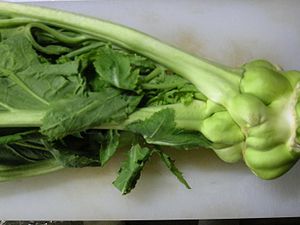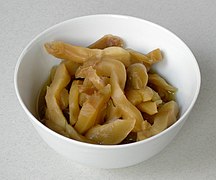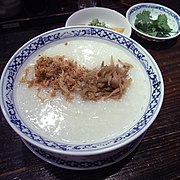Tsa Tsai
| Tsa Tsai | ||||||||||||
|---|---|---|---|---|---|---|---|---|---|---|---|---|

Fresh zha cai ( Brassica juncea subsp. Tsatsai ) |
||||||||||||
| Systematics | ||||||||||||
|
||||||||||||
| Scientific name | ||||||||||||
| Brassica juncea subsp. tsatsai | ||||||||||||
| (Mao) Gladis |
Tsa Tsai ( Brassica juncea . Subsp tsatsai Mao , Syn. : Brassica juncea var. Tumida Tsen & Shlee ; chinese 榨菜 , Pinyin Zhacai , W.-G. cha 4 -ts'ai 4 , Jyutping zaa 3 coi 3 ) is a in China cultivated a subspecies of the brown mustard ( Brassica juncea (L.) Czern. ), Which belongs to the genus of the cabbage vegetable ( Brassica ).
Origin and cultivation
The vegetable Tsa Tsai was mentioned and cultivated in writing as early as the Song period (960–1279). The cultivation region at the time of the Song was historically Fuzhou ( 涪 州 ) in Sichuan - today Fuling . Later, the cultivation of Tsa-Tsai expanded into regions of the provinces such as Zhejiang ( Jiaxing , Xiaoshan ), Guangdong ( Sihui ) or Hunan ( Xiangtan ). Today, Brassica juncea var. Tsatsai is grown mainly in the area around Wu Jiang and Yangtze River in China , where a very mild climate prevails. Tsa Tsai's production center is in Fuling in Chongqing .
Pickled Tsa Tsai was first brought to market in 1898 by a trader named Qiū Shòu'ān ( 邱壽安 / 邱寿安 ) through his spice and sauce shop ( 榮生昌 醬園 / 荣生昌 酱园 ). The idea for making the “pickled Tsai-Tsais” comes from Qiūs employee Dèng Bǐngchéng ( 鄧炳成 / 邓炳成 ). The name of the literally “pressed vegetables - Tsa Tsai” comes from the pressing process of the pickled food during production when picking the vegetables. Pickled Tsa Tsai from this region enjoy a particularly good reputation among connoisseurs. Most of the Tsa Tsai products sold worldwide come from this place. In China, pickled zha cai a comparable common food like the German sauerkraut , sour pickles (see spice , salt cucumber , o. Ä.) Or Korean kimchi .
description
It is an annual herbaceous plant . The young plants of this subspecies differ from other varieties of the species only in their somewhat finer structure and less hairiness . Typical of this variety are the thickening stem axis and the lumpy stems below the flower buds . A slender taproot is formed. The leaf blade has a length of 40 to 80 cm, the edge is almost entire, wavy or indistinctly toothed. The flowering time is between April and June, the fruits ripen between June and July.
use
Tsa Tsai, in German about "pressed vegetables" - known in Chinese restaurants as pickles with the name "pickled Szechuan vegetables" - is made from the thickened shoot , the lower parts of the stems and the approaches of the flower buds with parts of the stems and leaves. These are harvested in late winter, when vegetative growth has ceased and before the shoot begins to shoot. After the harvest, the plant parts are washed, cut in half or quartered, laid out on mats to dry, and when they are slightly wilted, they are placed in urn-shaped earthenware pots with salt , cayenne pepper and Szechuan pepper so that pressure is exerted on them. (Pressing process)
Salted Tsa Tsai has a mustard-yellow to greenish-brown color, a fleshy, firm consistency and an intense, salty and unmistakable taste. It is a traditional component of mostly simple dishes in Chinese cuisine , in which it was also used as a substitute for meat and a winter source of vitamins . Pickled Tsa Tsai is consumed alone in small quantities at the end of meals because it stimulates the flow of saliva and digestion , while cleaning the mouth. As home cooking , Tsa Tsai can be found in the Chinese breakfast, for example, as an accompaniment to rice congee or rice noodles . It is an ingredient in the Shanghai snack bar Cífàntuán - 糍 飯糰 / 糍 饭团 . As a main course , Tsa Tsai is known, for example, in the well-known “Dàndàn noodle” - 擔 擔 麵 / 担 担 面 from Sichuan or as “fried noodles with Tsa Tsai and strips of meat ” - 榨菜 肉絲 麵 / 榨菜 肉丝 面 .
- Tsa Tsai - 榨菜 as food
"Tsa-tsai heads" - pickled in chili
Dàndàn noodles with Tsa Tsai - Sichuan cuisine
Cífàntuán with Tsa Tsai - Shanghai cuisine
ingredients
Tsa Tsai contains the following substances, such as proteins , carotenes , fiber , aspartic acid , glutamic acid , minerals and 17 different amino acids . The values serve as a general orientation and are not fixed, as the environmental conditions of the growing area also have an influence on these values.
| Calorific value | water | fat | protein | carbohydrates | Fiber | sugar |
|---|---|---|---|---|---|---|
| 27 kJ (kcal) | ?? G | 0.1 g | 1.3 g | 6.5 g | 0.0024 g | 1.4 g |
| Sat. Fatty acids | Simple unsaturated Fatty acids | Multiple unsaturated Fatty acids | Folic acid |
|---|---|---|---|
| ?? mg | ?? mg | ?? mg | ?? µg |
| iron | copper | potassium | calcium | Magn. | sodium | phosphorus | selenium | zinc |
|---|---|---|---|---|---|---|---|---|
| 4.4 mg | ?? µg | ?? mg | 125 mg | ?? mg | ?? mg | ?? mg | ?? µg | ?? mg |
| β-carotene | Vita. A 1 | Vita. B1 | Vita. B2 | Vita. B3 | Vita. B5 | Vita. B6 | Vita. C. | Vita. K1 |
|---|---|---|---|---|---|---|---|---|
| ?? mg | 24.6 µg | ?? µg | ?? µg | ?? mg | ?? mg | ?? mg | 2 mg | ?? µg |
Source for tables:
- annotation
Trivia
The "Tsa Tsai Index" or "Zhaicai Index" ( 榨菜 指數 / 榨菜 指数 ) is a number that supposedly reflects the consumption of Tsa Tsai in the People's Republic of China and the general consumption and population movement within the country as this Everyday food is one of the general consumer goods of households and can be found in the shopping cart of simple Chinese migrant workers in particular . The origin of the term has not been clarified and is probably an invention of the media people (see Big Mac Index ) and not, claims such as in the media, a key figure (index), the governmental circles of the Chinese Commission for Development and Reform derived .
See also
Web links
- Tsa Tsai (Zhacai) - Brassica juncea tumida - Info (English)
- Tsa Tsai (Zhacai) - Sogou Article (Chinese)
- Tsa Tsai dishes (Chinese)
- Tsa Tsai Round (English)
Individual evidence
- ^ A b Shiu-ying Hu: Food Plants of China . 1st edition. The Chinese University Press, Hong Kong 2005, ISBN 962-201-860-2 (English).
- ↑ 張雪芹 / 张雪芹 - “Zhāng Xuěqín”: 不可 不知 的 歷史 常識 - 榨菜 的 由來 / 不可 不知 的 历史 常识 - 榨菜 的 由来 - “Historical general knowledge - Tsa Tsai's origin” . Ed .: 飛翔 時代 文化 傳媒 有限公司 / 飞翔 时代 文化 传媒 有限公司 , English Fly Time Culture Media Co. Ltd. . Beijing (Chinese, preview in Google Book Search - e-book version - official website ).
- ↑ 世界 三大 腌菜 之一 的 榨菜 是 怎么 诞生 的? 中国 榨菜 发展 史! - "The history of the origins of Tsa Tsai - How did Tsa Tsai, one of the three great pickled vegetables, come about?" In: www.qulishi .com. August 16, 2019, accessed March 12, 2020 (Chinese).
- ↑ 「榨菜」 名字 的 由來 - "The origin of the name of Tsa Tsai". In: kknews.cc. September 2, 2018, accessed March 12, 2020 (Chinese).
- ↑ Tai-yien Cheo: Brassica juncea var. Tumida . In: www.efloras.org. Retrieved March 12, 2020 (Flora of China, Volume 8, Brassicaceae).
- ↑ 榨菜 - 营养 成分 表 - "Tsa Tsai - nutrient table". In: fitness.39.net. Retrieved March 12, 2020 (Chinese).
- ↑ 榨菜 的 营养 价值 - "Nutritional Value of Tsa Tsai". In: www.meishij.net. Retrieved March 12, 2020 (Chinese).
- ↑ 彭 心 韫, 王洋 - Péng Xīnyùn, Wáng Yáng: 国家 发改委 : 未 提出 过 “榨菜 指数” 一词 - State Commission for Development and Reform: “Tsa Tsai Index: Never mentioned the term Tsa Tsai Index ". In: www.people.com.cn . August 16, 2013, accessed March 12, 2020 (Chinese).
- ↑ 榨菜 指数 - "Tsa-Tsai Index". In: wiki.mbalib.com. Retrieved March 12, 2020 (Chinese).




